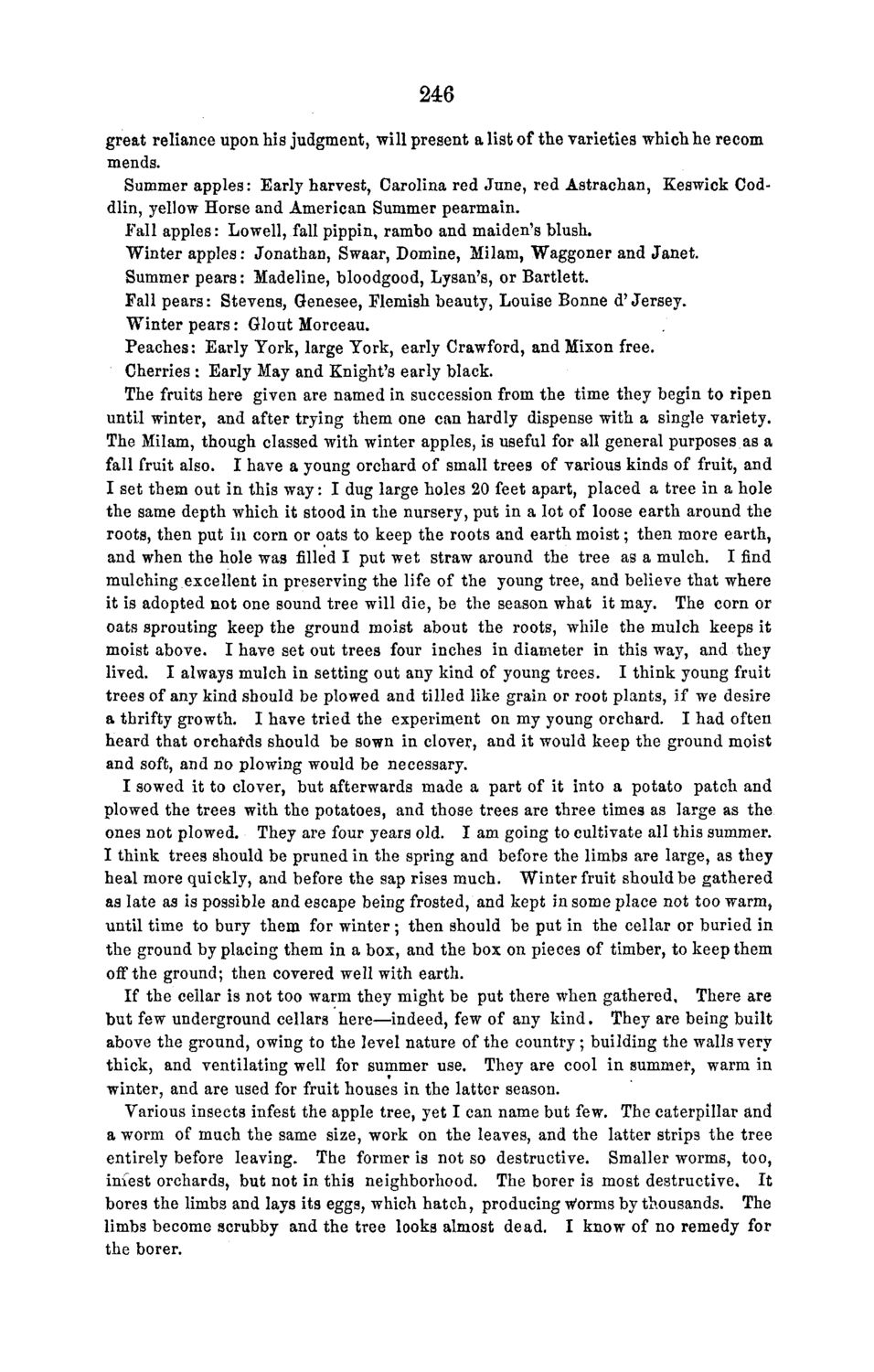| |
| |
Caption: Board of Trustees Minutes - 1868
This is a reduced-resolution page image for fast online browsing.

EXTRACTED TEXT FROM PAGE:
246 great reliance upon his judgment, will present a list of the varieties which he recom mends. Summer apples: Early harvest, Carolina red June, red Astrachan, Keswick Coddlin, yellow Horse and American Summer pearmain. Fall apples: Lowell, fall pippin, rambo and maiden's blush. Winter apples: Jonathan, Swaar, Domine, Milam, Waggoner and Janet. Summer pears: Madeline, bloodgood, Lysan's, or Bartlett. Fall pears: Stevens, Genesee, Flemish beauty, Louise Bonne d'Jersey. Winter pears: Glout Morceau. Peaches: Early York, large York, early Crawford, and Mixon free. Cherries : Early May and Knight's early black. The fruits here given are named in succession from the time they begin to ripen until winter, and after trying them one can hardly dispense with a single variety. The Milam, though classed with winter apples, is useful for all general purposes as a fall fruit also. I have a young orchard of small trees of various kinds of fruit, and I set them out in this way: I dug large holes 20 feet apart, placed a tree in a hole the same depth which it stood in the nursery, put in a lot of loose earth around the roots, then put in corn or oats to keep the roots and earth moist; then more earth, and when the hole was filled I put wet straw around the tree as a mulch. I find mulching excellent in preserving the life of the young tree, and believe that where it is adopted not one sound tree will die, be the season what it may. The corn or oats sprouting keep the ground moist about the roots, while the mulch keeps it moist above. I have set out trees four inches in diameter in this way, and they lived. I always mulch in setting out any kind of young trees. I think young fruit trees of any kind should be plowed and tilled like grain or root plants, if we desire a thrifty growth. I have tried the experiment on my young orchard. I had often heard that orchards should be sown in clover, and it would keep the ground moist and soft, and no plowing would be necessary. I sowed it to clover, but afterwards made a part of it into a potato patch and plowed the trees with the potatoes, and those trees are three times as large as the ones not plowed. They are four years old. I am going to cultivate all this summer. I think trees should be pruned in the spring and before the limbs are large, as they heal more quickly, and before the sap rises much. Winter fruit should be gathered as late as is possible and escape being frosted, and kept in some place not too warm, until time to bury them for winter ; then should be put in the cellar or buried in the ground by placing them in a box, and the box on pieces of timber, to keep them off the ground; then covered well with earth. If the cellar is not too warm they might be put there when gathered. There are but few underground cellars here—indeed, few of any kind. They are being built above the ground, owing to the level nature of the country ; building the walls very thick, and ventilating well for summer use. They are cool in summer, warm in winter, and are used for fruit houses in the latter season. Various insects infest the apple tree, yet I can name but few. The caterpillar and a worm of much the same size, work on the leaves, and the latter strips the tree entirely before leaving. The former is not so destructive. Smaller worms, too, iniest orchards, but not in this neighborhood. The borer is most destructive. It bores the limbs and lays its eggs, which hatch, producing w*orms by thousands. The limbs become scrubby and the tree looks almost dead. I know of no remedy for the borer.
| |